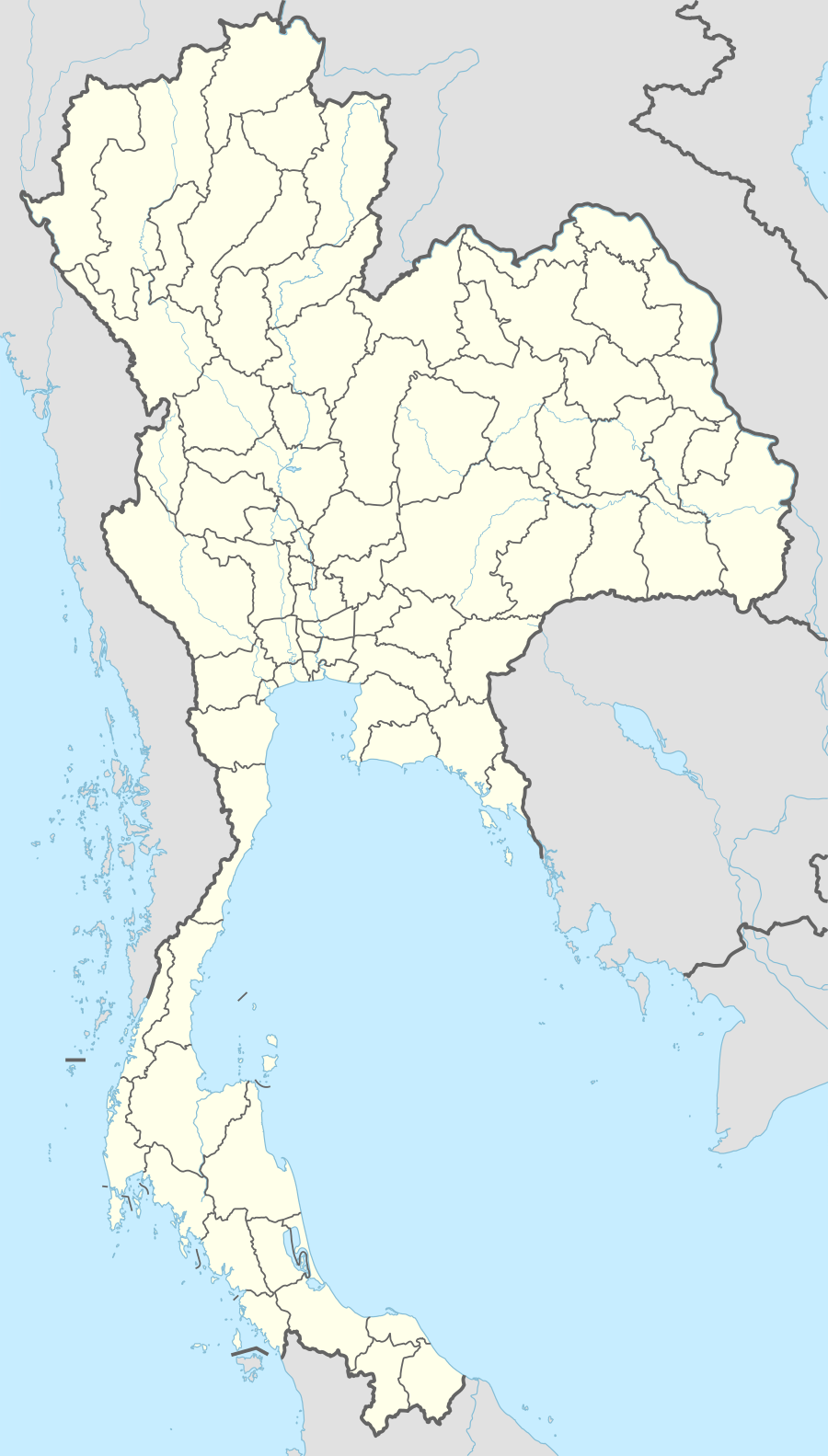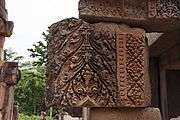Prasat Ta Muen Thom
| Prasat Ta Muen Thom | |
|---|---|
 | |
 Prasat Ta Muen Thom Location within Thailand | |
| Name | |
| Proper name | Prasat Ta Muen Thom |
| Geography | |
| Coordinates | 14°20′57″N 103°15′59″E / 14.34917°N 103.26639°ECoordinates: 14°20′57″N 103°15′59″E / 14.34917°N 103.26639°E |
| Country | Thailand |
| State/province | Surin Province |
| Location | Thai-Cambodian border |
| Culture | |
| Primary deity | Shiva |
| Architecture | |
| Architectural styles | Khmer |
| History and governance | |
| Date built | 11th century[1] |
| Creator | Udayadityavarman II |
Prasat Ta Muen Thom (Khmer: ប្រាសាទតាមាន់ធំ, Thai: ปราสาทตาเมือนธม, rtgs: Prasat Ta Muean Thom) is a Khmer temple in Thailand located in the province of Surin, a few dozen meters from the border with Cambodia's Oddar Meanchey Province. Its Khmer name translates literally to "Great Temple of Grandfather Chicken". It lies not far from two related temples in a densely forested area where access is difficult on one of the passes through the Dangrek Mountains. Prasat Ta Muen Toch ("Minor Temple of Grandfather Chicken"), the hospital chapel, lies two and half kilometers to the northwest and just 300 meters beyond that is the rest house chapel, Prasat Ta Muen ("Temple of Grandfather Chicken"). During the 1980s-90s, when the Khmer Rouge controlled the area, the temples in the region were looted by the Khmer Rouge to finance their guerrilla campaign. Many architectural pieces and original sculptures were stolen, sometimes detached using dynamite, and smuggled out of Cambodia or sold on the black market.[2] These three temples, all within a few hundred meters of each other, formed a complex which was an important stop on a major route of the Khmer Empire, the Ancient Khmer Highway from its capital at Angkor to its major administrative center in the northwest, Phimai (now in Thailand).[3]
Layout
The temple is located in the Ta Muen Thom pass at the top of the escarpment of the Dangrek Mountains which forms the current border between Cambodia and Thailand in the region. North of the border is the Khorat Plateau while to the south are steep cliffs as the mountains form sheer drops down to the plains Northwest Cambodia. Ta Muen Thom is constructed of laterite[1] and laid out in a rectangular plan with the entrance facing south, highly unusual for Khmer temples which usually face east. It is suspected that this is due to the topography, both to meet travelers having just climbed the pass from the plains below and to provide a defensible position with a strategic view southward down the mountains.[4] The temple's enclosure is 46 meters by 38 meters with its center in a central sanctuary constructed of pinkish-grey sandstone and preceded by a mandapa and an antarala. A natural channel in the bedrock was used as the somasutra, a funnel which transported holy water used in rituals from the statue in the main chamber, which flows out from the garbhagriha and indicates the relative importance of the site.[4]
On the north side are two towers and two other laterite buildings that are still standing as well as the foundations of three other buildings which are no longer standing. These buildings are the remains of the highway rest house and hospital Jayavarman VII erected to add to the temple complex where pilgrims and travelers would spend the night and recuperate for the next leg of their journey.[4] On the south facade, the same side as the main entrance, is the main gopura, which is much larger than the others. A large broad steep laterite staircase, also facing south and extending well down into Cambodian territory, leads to the entrance of the temple. There is also a laterite staircase that leads down to a stream on the Cambodian side which curves around the temple.[4] The orientation of Ta Muen Thom is very similar to that of Prasat Hin Phimai and others at Phimai Historical Park.
Recent excavations inside the main tower have revealed the existence of a natural linga protruding from the top of the hill around which the temple was built.[4] There is a similar natural linga at the Khmer temple Vat Phou in Laos.
Access
Because of its location on the Thai side of the current border, the temple is only accessible from Thailand. Access from Cambodia would be difficult because the ancient Khmer Highway that led to the pass has long since been retaken by the jungle. During the Cambodian–Thai border dispute (2009-20011) which was primarily centered around ownership of Preah Vihear Temple, border clashes spread to Ta Muen and access to the temple was temporarily closed. Afterwards, tensions remain high and tourists at the temple are not allowed to venture more than a few meters southward from the main entrance and armed Thai border police stand guard to mark the border.[5]
Gallery
| Prasat Ta Muen Thom | ||||||||
|---|---|---|---|---|---|---|---|---|
|
Notes
- 1 2 Uchida, Etsuo; Ito, K.; Shimizu, N. (2010). "Provenance of the Sandstone Used in the Construction of the Khmer Monuments in Thailand" (PDF). Archaeometry. 52 (4). doi:10.1111/j.1475-4754.2009.00505.x. Retrieved 11 November 2015.
- ↑ Freeman, Michael (2004). Cambodia. Reaktion Books. p. 108. ISBN 1861894465. Retrieved 11 November 2015.
- ↑ Gaucher, Jacques (1992). "A propos d'une visite des sites khmers de Thaïlande". Bulletin de l'Ecole française d'Extrême-Orient. 79 (1). Retrieved 11 November 2015.
- 1 2 3 4 5 Charuwan, Phungtian (2000). Thai-Cambodian Culture: Relationship through the Arts (PDF). Magadh University, India: Buddha Dharma Education Association Inc. Retrieved 11 November 2015.
- ↑ Panchali, Saikia (August 2012). "The Dispute over Preah Vihear: Seen Problems, Unseen Stakes" (PDF). IPCS Special Report. Institute of Peace and Conflict Studies. 129. Retrieved 11 November 2015.
References
- Michael Freeman, A guide to Khmer temples in Thailand & Laos, Rivers Books, 1996 974-8900-76-2
- Michael Freeman, Palaces of the Gods: Khmer Art & Architecture in Thailand, River Books, 2001 974-8303-19-5
- Yoshiaki Ishizawa, Along The Royal Roads To Angkor, Weatherhill, 1999 083-4804-72-7
- Claude Jacques and Philippe Lafond, The Khmer Empire, River Books, 2007 974-9863-30-5
- Vittorio Roveda, Images of the gods: khmer mythology in Cambodia, Thailand and Laos, River Books, 2005 974-9863-03-8
- Betty Gosling, Origins of thai art, River Books, 2004 0-8348-0541-3



